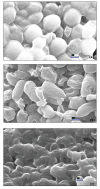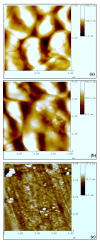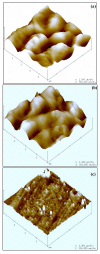Liquid and vapour-phase antifungal activities of selected essential oils against Candida albicans: microscopic observations and chemical characterization of Cymbopogon citratus
- PMID: 21067604
- PMCID: PMC2994787
- DOI: 10.1186/1472-6882-10-65
Liquid and vapour-phase antifungal activities of selected essential oils against Candida albicans: microscopic observations and chemical characterization of Cymbopogon citratus
Abstract
Background: Use of essential oils for controlling Candida albicans growth has gained significance due to the resistance acquired by pathogens towards a number of widely-used drugs. The aim of this study was to test the antifungal activity of selected essential oils against Candida albicans in liquid and vapour phase and to determine the chemical composition and mechanism of action of most potent essential oil.
Methods: Minimum Inhibitory concentration (MIC) of different essential oils in liquid phase, assayed through agar plate dilution, broth dilution & 96-well micro plate dilution method and vapour phase activity evaluated through disc volatilization method. Reduction of C. albicans cells with vapour exposure was estimated by kill time assay. Morphological alteration in treated/untreated C. albicans cells was observed by the Scanning electron microscopy (SEM)/Atomic force microscopy (AFM) and chemical analysis of the strongest antifungal agent/essential oil has been done by GC, GC-MS.
Results: Lemon grass (Cymbopogon citratus) essential oil exhibited the strongest antifungal effect followed by mentha (Mentha piperita) and eucalyptus (Eucalyptus globulus) essential oil. The MIC of lemon grass essential oil in liquid phase (288 mg/l) was significantly higher than that in the vapour phase (32.7 mg/l) and a 4 h exposure was sufficient to cause 100% loss in viability of C. albicans cells. SEM/AFM of C. albicans cells treated with lemon grass essential oil at MIC level in liquid and vapour phase showed prominent shrinkage and partial degradation, respectively, confirming higher efficacy of vapour phase. GC-MS analysis revealed that lemon grass essential oil was dominated by oxygenated monoterpenes (78.2%); α-citral or geranial (36.2%) and β-citral or neral (26.5%), monoterpene hydrocarbons (7.9%) and sesquiterpene hydrocarbons (3.8%).
Conclusion: Lemon grass essential oil is highly effective in vapour phase against C. albicans, leading to deleterious morphological changes in cellular structures and cell surface alterations.
Figures





References
-
- Koneman EW, Allen SD, Janda WM, Schreckenberger PC, Winn WC. , Jr. Microbiological diagnosis: text and color atlas. 5. Rio de Janeiro: Medsi; 2001. p. 1465.
-
- Xu YY, Samaranayake YH, Samaranayake LP. In vitro susceptibility of Candida species to lactoferrin. Med Mycol. 1999;37:35–41. - PubMed
MeSH terms
Substances
LinkOut - more resources
Full Text Sources
Other Literature Sources
Miscellaneous

